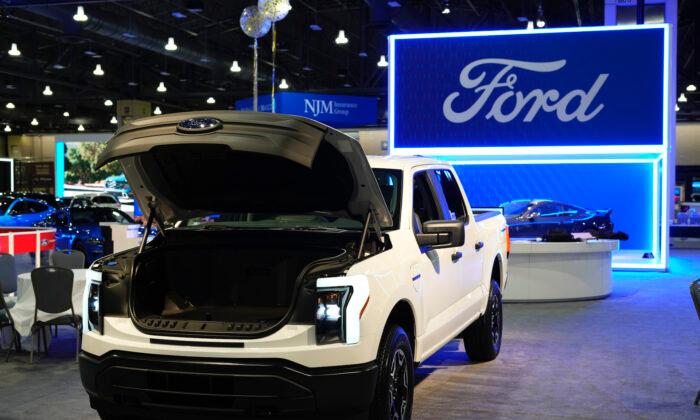A little more than half of all Ford dealers have opted to sell electric vehicles (EV) in 2024, down from roughly two-thirds that expressed a willingness to do so at about the same time last year, which comes as EV enthusiasm appears to be cooling.
About 1,550 Ford dealers have opted to sell EVs in 2024, Ford spokesman Martin Gunsberg told The Epoch Times in an emailed statement.
About a year ago, Ford CEO Jim Farley said two-thirds of Ford dealers were committed to selling EVs, according to the Detroit Free Press, which reported that 1,920 dealers had pledged to go all-in on Ford’s voluntary EV program.
“EV adoption rates vary across the country,” Mr. Gunsberg told The Epoch Times. “As dealers have completed their own due diligence in their local markets, dealer enrollments for 2024 entry have stabilized at just over 50 percent of the network (about 1,550 dealers).”
He noted that this enrollment level puts 86 percent of the population within 20 miles of a Ford dealership capable of selling and servicing an EV manufactured by Ford.
“When it comes to Ford’s voluntary EV Program, Ford dealers have a choice of two enrollment levels and two enrollment entry points (2024 and 2027). If a dealer chooses to not participate in the EV Program, they can continue to sell ICE and hybrid vehicles,” Mr. Gunsberg said.
The latest data suggest waning enthusiasm among dealers to carry EVs. Part of the reason could be that Ford has required dealers who want to offer Ford EVs to make large investments, including in DC fast chargers that allow each sales lot to double as a charging station for owners.
Another factor could be a slowdown in EV sales after an initial wave of adoption enthusiasm amid a lack of charging infrastructure, reliability issues, and persistent concern about “range anxiety,” the fear that an EV will run out of power and leave its driver stranded with no chargers around for miles.Waning EV Demand
Although EV sales in the United States hit a record 313,086 in the third quarter of 2023, many carmakers are sounding the alarm, saying demand isn’t keeping up with expectations, forcing them to scale back some EV expansion plans.Honda and General Motors announced recently that they were scrapping a $5 billion plan to develop EVs together, and GM stated that it was slowing its electrification strategy.
GM Chief Financial Officer Paul Jacobson said during an Oct. 24 earnings call with reporters that the company is “moderating the acceleration of EV production to protect ... pricing, adjust to slower near-term growth in demand and implement engineering changes that will bolster profits.”
Ford stated in October that it would cut future EV investments by $12 billion compared with previous plans.
In July, during Ford’s second-quarter earnings briefing, Mr. Farley said Ford would slow the ramp-up of money-losing EVs and shift investment to Ford’s commercial vehicle unit, citing plans to quadruple sales of gas-electric hybrids over the next five years.
Like many of its competitors, Ford is “trying to find the balance between price, margin, and EV demand,” Chief Financial Officer John Lawler said at the briefing.
Range Anxiety
A recent study by the American Automobile Association (AAA) found that EV range can fall by up to a quarter when the vehicle is carrying heavy loads.“Range anxiety remains a top reason consumers are hesitant to switch from gasoline-powered vehicles to EVs,” Adrienne Woodland, spokesperson for AAA, said in a statement.
President Joe Biden has pledged to grow the nationwide network of public EV chargers to 1.2 million by 2030 amid the administration’s push to reach net zero by 2050.
So far, just one EV charger has been built as part of a $7.5 billion program introduced by President Biden’s 2021 infrastructure bill to expand the charging infrastructure sharply.

Other EV Concerns
Besides range anxiety and limited charging infrastructure, other concerns have weighed on EV adoption, including cost and reliability.The report found that various subsidies, regulatory credits, and charging costs of an average EV from the model year 2021 add $53,267 to the vehicle’s price over a decade.
Assuming that the EV is driven for 10 years at 120,000 miles, this would make the “true cost of fueling” equivalent to paying $17.33 per gallon of gasoline—many times higher than the $1.21 per gallon claimed by other estimates.
“This analysis shows that electricity is a long way from becoming a cost-effective transportation fuel compared to gasoline,” the report reads. “Without increased and sustained government favors, EVs will remain more expensive than ICEVs [internal combustion engine vehicles] for many years to come.”
Although the differences varied across segments and depended on whether charging was done at home or commercially, the results of the AEG study made a strong case that going electric simply costs more.
The least reliable were plug-in hybrids, which had 146 percent more problems than gas vehicles.
Surprisingly, however, the most reliable vehicles, per the survey, were regular hybrids.
According to Consumer Reports, some of the most common problems reported by owners of EVs are issues with electric drive motors, charging, and EV batteries.







